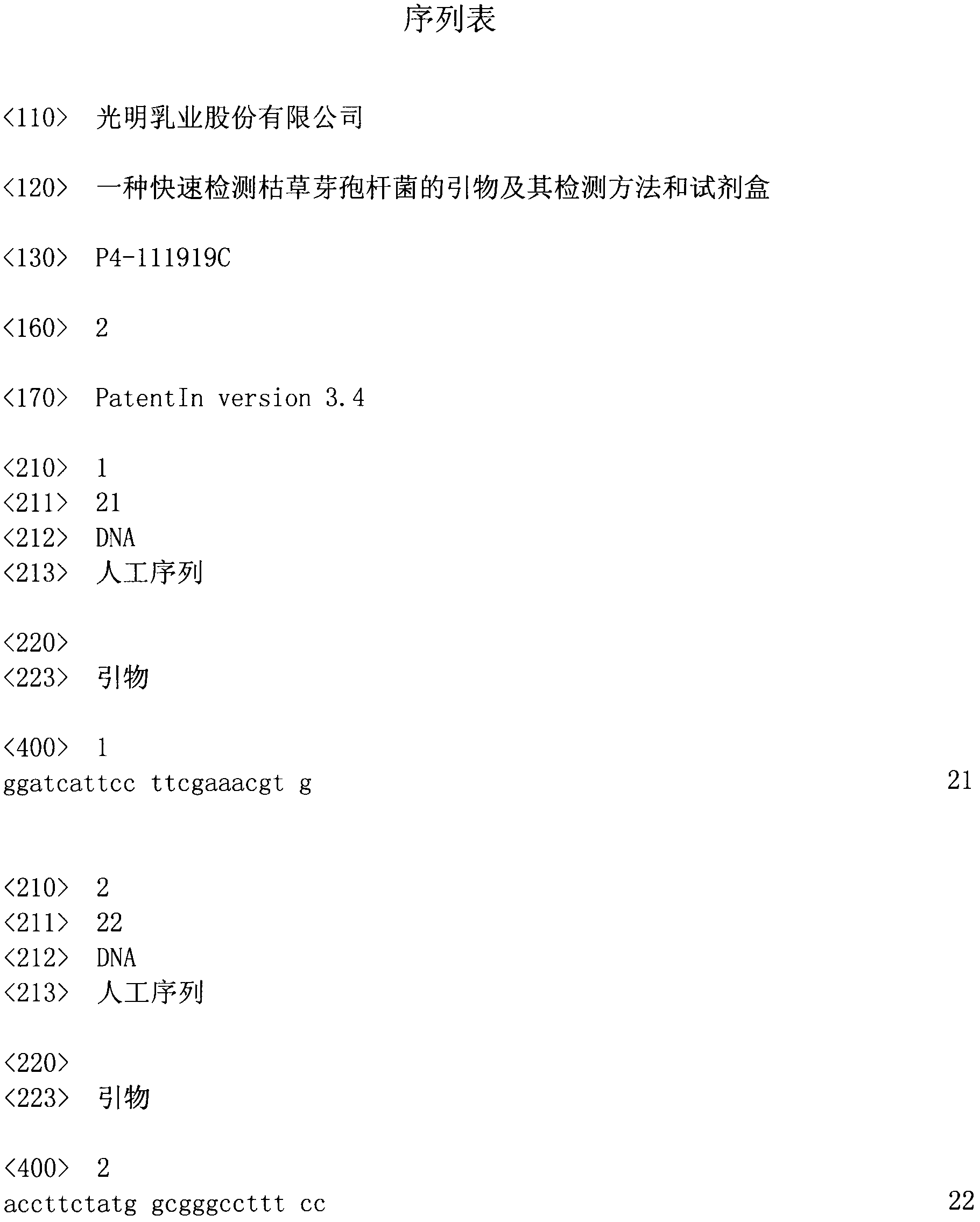Primer and detection method as well as kit for rapidly detecting bacillus subtilis
A technology for Bacillus subtilis and a detection method is applied in the field of a primer for rapid detection of Bacillus subtilis, a detection method and a kit, which can solve the problems of complicated operation, long time consumption and the like, and achieve the effects of simple operation, high sensitivity and low cost.
- Summary
- Abstract
- Description
- Claims
- Application Information
AI Technical Summary
Problems solved by technology
Method used
Image
Examples
Embodiment 1
[0024] Detection of Bacillus subtilis in embodiment 1 fresh milk
[0025] Take 10ml of fresh milk, centrifuge at 6000g for 10min, discard the supernatant, and take the precipitate. The precipitate was washed twice with deionized water, and the bacterial genomic DNA was extracted with a lysis reagent (Lysis Buffer for Microorganism to Direct PCR, purchased from TaKaRa Company). Then PCR reaction was carried out using the extracted DNA as a template.
[0026] The PCR reaction system was: 3 μL of 5 μmol / L upstream primer, 3 μL of 5 μmol / L downstream primer, 2.4 μL of 2.5 mmol / L dNTP (TaKaRa company), 10×PCR Buffer (Taq TM , TaKaRa Company) 3 μL, template DNA 1 μL, Taq DNA polymerase (Taq TM , TaKaRa Company) 1U, add deionized water to 30 μL.
[0027] The PCR reaction program was: preheating at 95°C for 5 minutes, 35 cycles (95°C, 30S; 55°C, 30S; 72°C, 30S), extension at 72°C for 5min, and storage at 4°C.
[0028] Finally, electrophoresis detection was carried out, and 5 μL of...
Embodiment 2
[0030] The bacillus subtilis inspection of colony on the embodiment 2 culture plate
[0031] The sample to be tested is soybean milk purchased from a supermarket. After gradient dilution of the purchased soybean milk, select 2 to 3 appropriate dilutions, spread 0.1 mL each on an LB agar plate, and incubate aerobically at 37°C for 48 hours. Pick 3 or more suspicious colonies, use lysis reagent (Lysis Buffer for Microorganism to Direct PCR, TaKaRa Company) to extract bacterial genomic DNA and dilute it for future use. Then the PCR reaction was carried out using the extracted bacterial genome DNA as a template.
[0032] The PCR reaction system was: 3 μL of 5 μmol / L upstream primer, 3 μL of 5 μmol / L downstream primer, 2.4 μL of 2.5 mmol / L dNTP (TaKaRa company), 10×PCR Buffer (Taq TM , TaKaRa Company) 3 μL, template DNA 1 μL, Taq DNA polymerase (Taq TM , TaKaRa Company) 1U, add deionized water to 30 μL.
[0033] The PCR reaction program was: preheating at 95°C for 5 min, 35 cyc...
Embodiment 3
[0037] Embodiment 3 detection method sensitivity test
[0038] The pure cultured Bacillus subtilis was diluted and counted under a microscope with a hemocytometer. Dilute the bacterial solution to a copy number of 3×10 5 / mL, 3×10 4 / mL, 3×10 3 / mL, 3×10 2 / mL, 3×10 1 / mL before the experiment. Genomic DNA of each gradient cell was extracted with a lysis reagent (Lysis Buffer for Microorganism to Direct PCR, TaKaRa Company) and diluted for later use. Then the PCR reaction was carried out using the extracted bacterial genome DNA as a template.
[0039] The PCR reaction system was: 3 μL of 5 μmol / L upstream primer, 3 μL of 5 μmol / L downstream primer, 2.4 μL of 2.5 mmol / L dNTP (TaKaRa company), 10×PCR Buffer (Taq TM , TaKaRa Company) 3 μL, template DNA 1 μL, Taq DNA polymerase (Taq TM , TaKaRa Company) 1U, add deionized water to 30 μL.
[0040] The PCR reaction program was: preheating at 95°C for 5 min, 35 cycles (95°C, 30s; 55°C, 30s; 72°C, 30s), extension at 72°C for 5...
PUM
 Login to View More
Login to View More Abstract
Description
Claims
Application Information
 Login to View More
Login to View More - R&D
- Intellectual Property
- Life Sciences
- Materials
- Tech Scout
- Unparalleled Data Quality
- Higher Quality Content
- 60% Fewer Hallucinations
Browse by: Latest US Patents, China's latest patents, Technical Efficacy Thesaurus, Application Domain, Technology Topic, Popular Technical Reports.
© 2025 PatSnap. All rights reserved.Legal|Privacy policy|Modern Slavery Act Transparency Statement|Sitemap|About US| Contact US: help@patsnap.com

